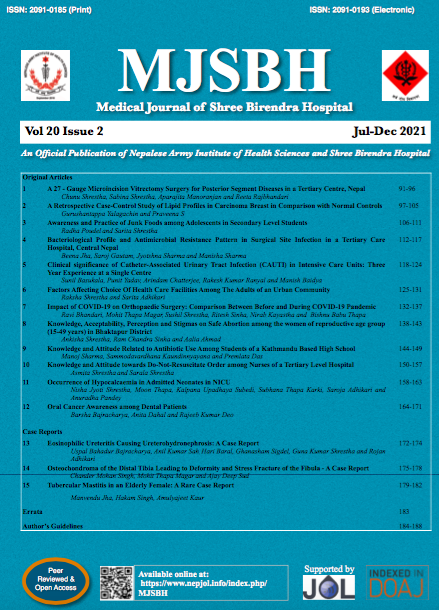Bacteriological Profile and Antimicrobial Resistance Pattern in Surgical Site Infection in a Tertiary Care Hospital, Central Nepal
DOI:
https://doi.org/10.3126/mjsbh.v20i2.33399Keywords:
Clean and clean-contaminated wound, MRSA, Post-operative wound infections, Staphylococcus aureus, Surgical site infectionsAbstract
Introduction: Surgical site wound infections (SSI) are the third most commonly reported nosocomial infection and they account for approximately a quarter of all nosocomial infections. Apart from bacterial contamination of wound, various patient and environment related factors play a role in development and outcome of SSI. The present study is undertaken to study the frequency of SSI and the antimicrobial resistance pattern of the causative organisms isolated.
Methods: This cross-sectional prospective study was carried out over a period of one year. A total of 245 pus samples from suspected cases of surgical site infections were processed for gram staining, culture, biochemical identification tests and antimicrobial susceptibility testing using standard microbiological protocol. Data was analysed using software word version SPSS 19.
Results: The overall frequency of SSI was 13.87%. Most common isolates were staphylococcus aureus and Escherichia coli. All four staph aureus strains were resistant to penicillin and cefixime but were 100% sensitive to vancomycin and cloxacillin. Two out of four stains were methicillin resistant Staph. aureus (MRSA). Another concern in recent time is the isolation of acinetobacter from surgical wounds.
Conclusions: Preoperative antibiotics, reduced hospital stay and proper control of co-morbidities decrease the incidence of post-operative infections. Marked resistance of isolates to commonly used antibiotics signifies the need for judicious and rational use of these drugs to prevent the emergence of antibiotic resistant strains.
Downloads
Downloads
Published
How to Cite
Issue
Section
License
Copyright (c) 2021 Medical Journal of Shree Birendra Hospital

This work is licensed under a Creative Commons Attribution-NonCommercial-NoDerivatives 4.0 International License.
This license enables reusers to distribute, remix, adapt, and build upon the material in any medium or format for noncommercial purposes only, and only so long as attribution is given to the creator.




